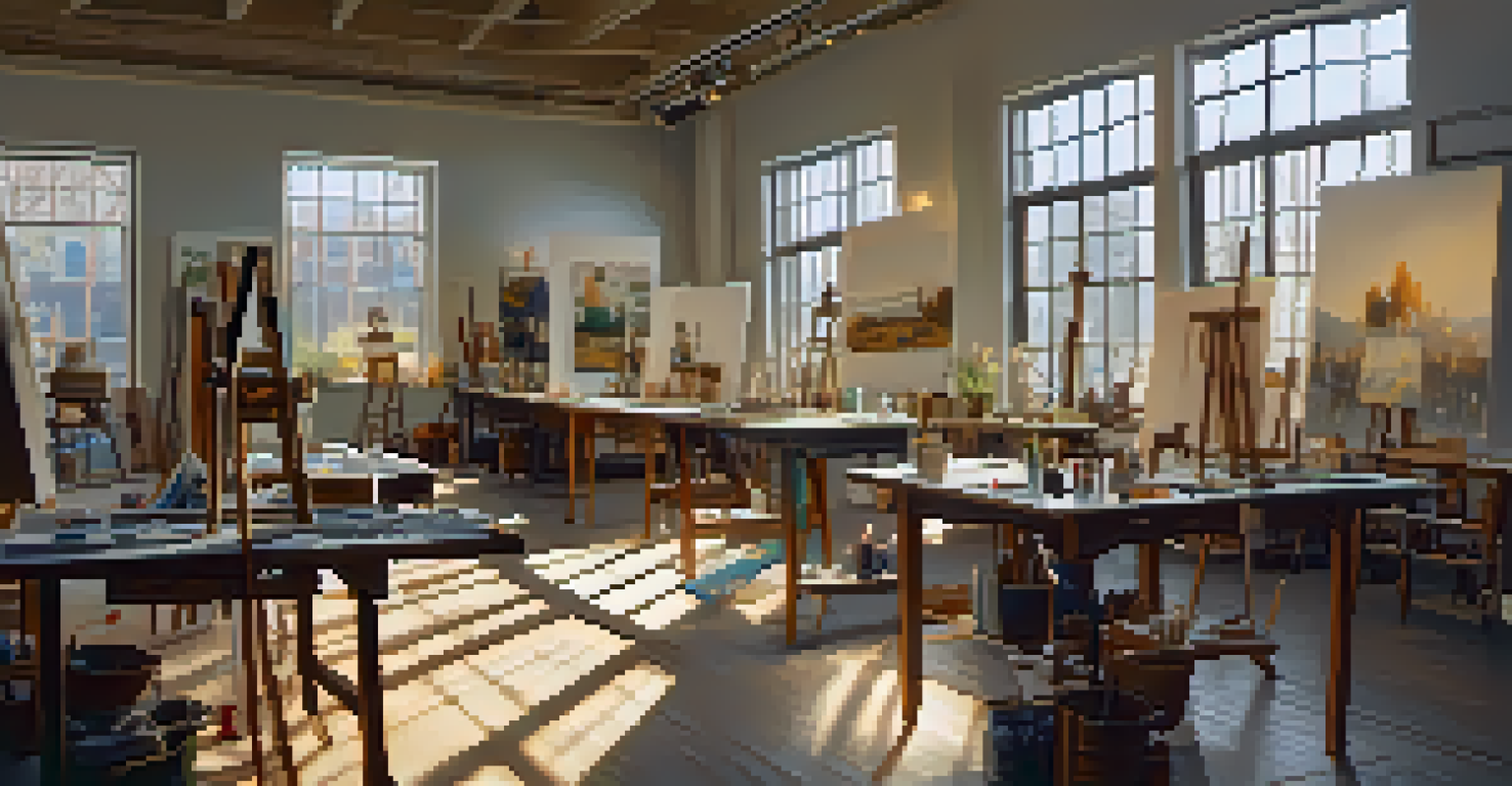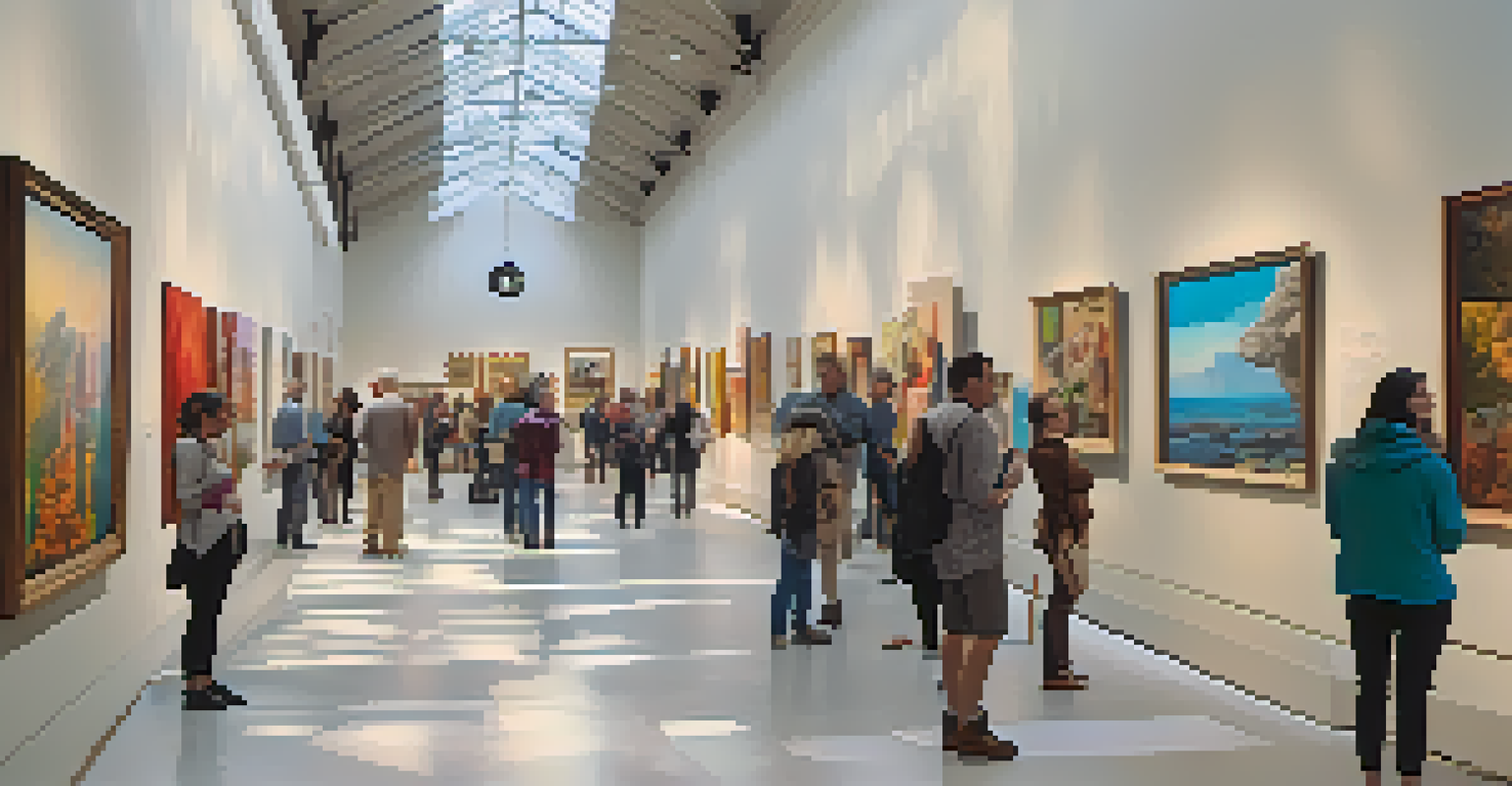The Relationship Between Art Institutions and Local Artists

Understanding the Role of Art Institutions in Communities
Art institutions serve as cultural hubs, fostering creativity and community engagement. They not only showcase artworks but also create spaces for dialogue and connection among artists and the public. By offering exhibitions, workshops, and events, these institutions help local artists gain visibility and recognition.
Art is not what you see, but what you make others see.
Moreover, art institutions often provide resources such as grants, mentorship programs, and professional development opportunities. This support can be crucial for emerging artists who might otherwise struggle to navigate the art world. By investing in local talent, institutions contribute to a vibrant and diverse cultural landscape.
Ultimately, the relationship between art institutions and communities is symbiotic. While institutions benefit from the fresh perspectives and innovations that local artists bring, artists gain a platform to share their work and engage with wider audiences. This partnership enriches the cultural fabric of the area, making it a more dynamic space for everyone.
The Importance of Collaboration for Local Artists
Collaboration between local artists and art institutions can lead to exciting projects that elevate community engagement. When artists partner with institutions, they can create unique exhibitions or events that reflect local culture and stories. This collaboration not only showcases the artists' talents but also invites the community to participate in the creative process.

For example, a local artist might work with an institution to design a mural that celebrates the history of the neighborhood. This not only beautifies the space but also fosters a sense of pride among residents. Such projects can draw attention to the importance of local narratives and encourage more people to explore art in their community.
Art Institutions Foster Community
Art institutions create cultural hubs that promote creativity, engagement, and connection between artists and the community.
Additionally, these partnerships often result in educational programs tailored to the needs of the community. Workshops and artist talks can provide valuable insights, helping local residents appreciate art while learning about the creative process. This kind of engagement deepens the relationship between artists and their audience, making art more accessible and relatable.
Supporting Emerging Talent Through Art Institutions
Emerging artists often face challenges such as limited exposure and lack of resources. Art institutions play a vital role in bridging this gap by providing platforms that showcase new talent. Through curated exhibitions or open calls, these institutions can highlight the work of up-and-coming artists, giving them the recognition they need to thrive.
The role of the artist is to make the world a better place through creativity and collaboration.
Moreover, art institutions can offer mentorship opportunities, connecting emerging artists with established professionals in the field. This guidance can be invaluable as it helps young artists hone their skills and navigate the complexities of the art world. Institutions that prioritize mentorship create a nurturing environment that fosters growth and innovation.
By actively supporting emerging talent, art institutions not only enrich their own programs but also contribute to the future of the arts. A diverse and vibrant artistic community relies on the fresh ideas and perspectives of new artists. By uplifting these voices, institutions ensure that the art scene remains dynamic and reflective of the society it serves.
Challenges Faced by Local Artists in Art Institutions
While art institutions provide numerous benefits, local artists may also encounter challenges within these spaces. One common issue is the perception that institutions favor established artists, leaving emerging talent feeling overlooked. This can create barriers for local artists trying to gain recognition and build their careers.
Additionally, the bureaucratic nature of some institutions may hinder flexibility and creativity. Local artists might find it difficult to propose unconventional ideas or projects that don't fit the traditional mold. This rigidity can stifle innovation and discourage artists from pursuing collaborations.
Collaboration Enriches Local Art
Partnerships between local artists and institutions lead to unique projects that reflect community stories and foster pride.
Finally, funding limitations can restrict the types of programs that institutions offer to support local artists. Without adequate resources, institutions may struggle to provide the comprehensive support that artists need. Addressing these challenges requires ongoing dialogue between artists and institutions to ensure that all voices are valued and heard.
The Impact of Technology on Art Institutions and Artists
In today's digital age, technology has transformed the way art institutions and local artists interact. Social media platforms allow artists to share their work with a global audience, breaking down geographical barriers. This newfound visibility can lead to opportunities that were previously inaccessible, such as collaborations with international institutions.
Art institutions, too, are leveraging technology to enhance their outreach and engagement. Virtual exhibitions and online workshops have become essential tools for connecting with audiences in innovative ways. By embracing technology, institutions can reach diverse communities, ensuring that art remains inclusive and accessible.
However, with the rise of technology, there is also the risk of oversaturation. Local artists may find it challenging to stand out in an ever-growing digital landscape. To combat this, institutions can provide guidance on digital marketing and branding, helping artists navigate the complexities of promoting their work online.
Celebrating Local Culture Through Art Institutions
Art institutions have the unique opportunity to celebrate and promote local culture through their programming. By showcasing works that reflect the community's history, values, and stories, institutions can foster a sense of belonging and pride among residents. This not only enriches the local art scene but also strengthens community ties.
For instance, an institution might curate an exhibition that highlights the contributions of local artists from diverse backgrounds. By doing so, they acknowledge the richness of the community's cultural heritage. This celebration of local culture can inspire residents to engage with the arts and express their own stories through various mediums.
Supporting Emerging Artists Matters
Art institutions play a crucial role in supporting emerging talent by providing exposure, mentorship, and resources for growth.
Furthermore, institutions can collaborate with local organizations to host events that promote cultural exchange and understanding. These initiatives create spaces where different voices can be heard, fostering a deeper appreciation for the arts. Celebrating local culture through art not only benefits institutions and artists but also enhances the overall vibrancy of the community.
The Future of Art Institutions and Local Artists Collaboration
As we look to the future, the relationship between art institutions and local artists will continue to evolve. With increasing awareness of the importance of inclusivity and representation, institutions are becoming more committed to showcasing diverse voices. This shift is vital for ensuring that the art world reflects the richness of society and its myriad experiences.
Moreover, as communities become more interconnected, the potential for collaboration grows. Local artists can engage with institutions to create innovative projects that resonate with their audiences. This collaborative spirit not only enriches artistic practices but also fosters a sense of community ownership over cultural spaces.

Ultimately, the future of art institutions and local artists lies in shared values and mutual respect. By continuing to prioritize collaboration and support for local talent, institutions can help cultivate a thriving artistic ecosystem. This partnership will not only benefit individual artists but also contribute to a vibrant cultural landscape that inspires future generations.